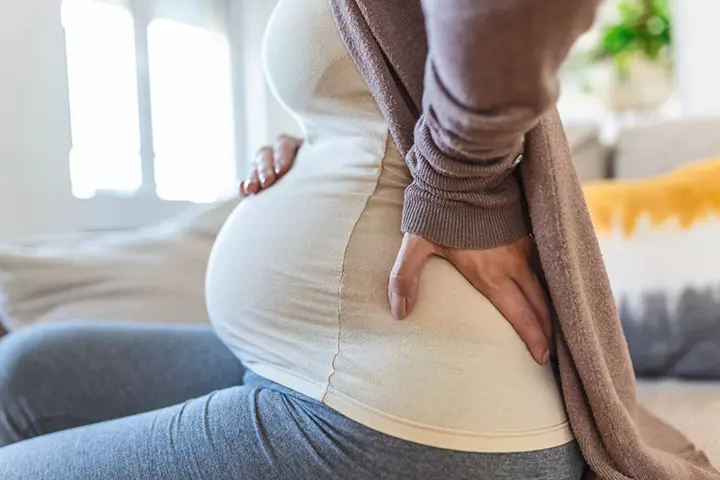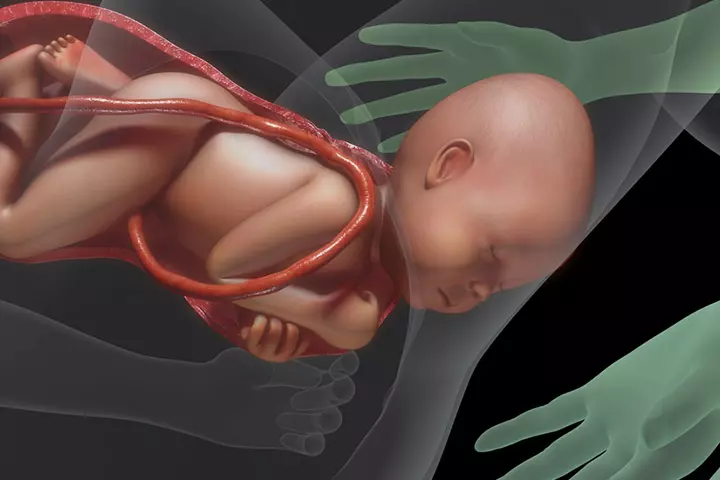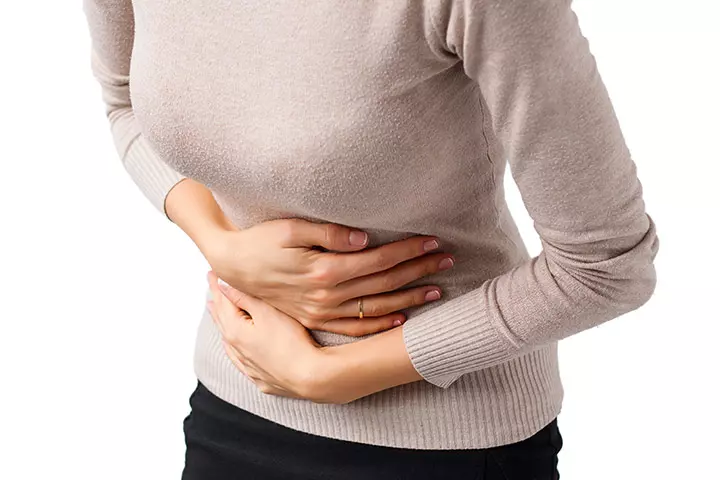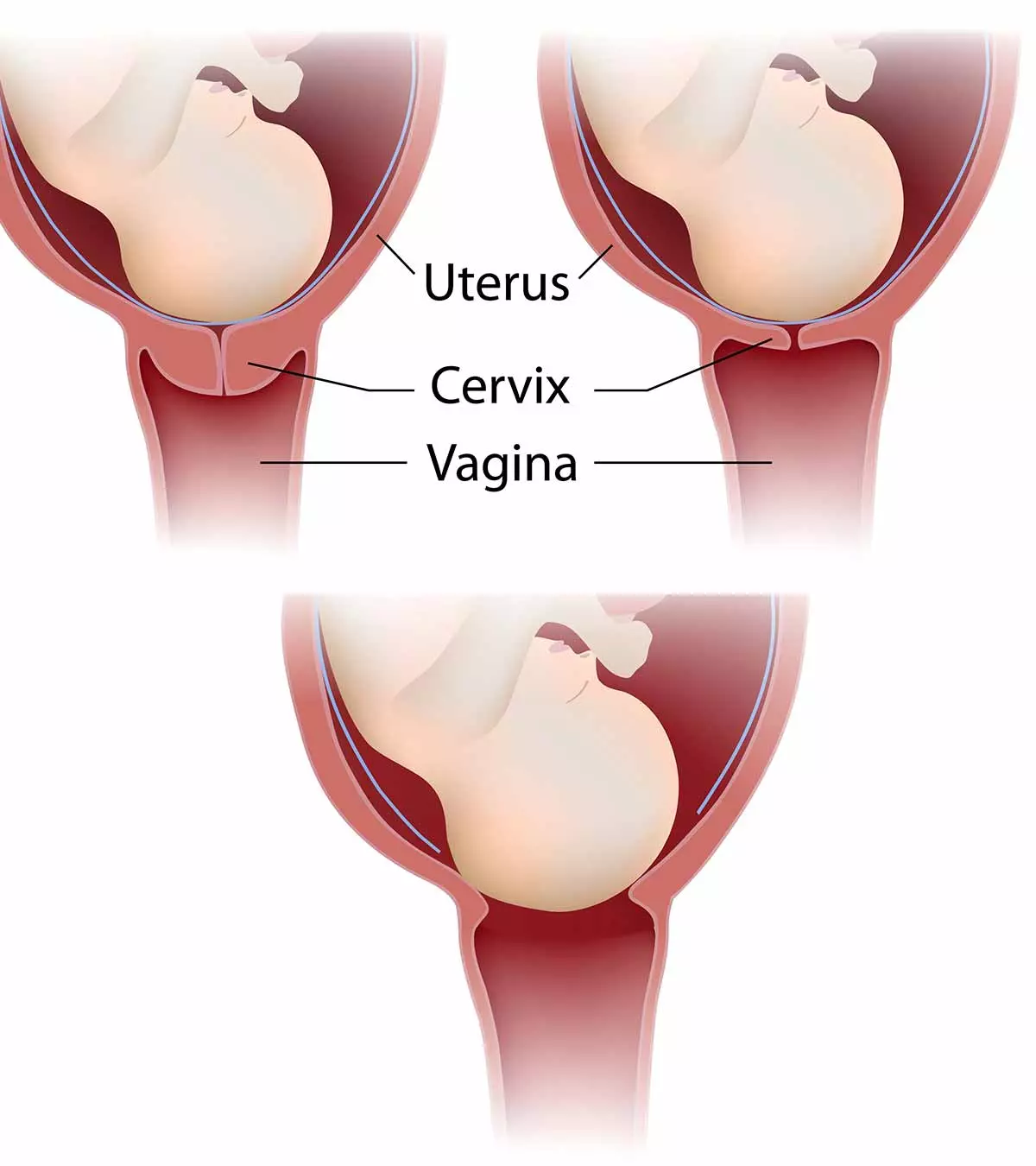
Image: iStock
Childbirth is one of the most fulfilling experiences for mothers, but it can be painful. But how painful is childbirth? It may vary among women depending on various factors. Research also shows some women opt for cesarean sections due to the fear of labor pain (1). However, there are various natural ways and medications to reduce the pain during labor and delivery.

If you haven’t used pain relief earlier during pregnancy, do not hesitate to ask for some relief if overwhelmed by pain during labor. Considering all options of pain relief can be helpful for mothers, especially first-time mothers. Knowing the options available ahead of time could reduce your fear and anxiety, and you may avail them if required.
Read about how painful childbirth is, what giving birth feels like, and the natural and pharmacological ways of pain relief before and during labor and childbirth.
How Painful Is Childbirth?

No two births are the same, whether natural or emergency cesarean section. The labor and delivery experience is complex and subjective, and several factors influence a woman’s perception of labor pain and make the experience unique. Labor pain is ranked high on the pain rating scale compared to other pains.
Most women experience discomfort and dull ache in their back and lower abdomen and pressure in the pelvis. Pain can also radiate to the thighs and sides of the body. Uterine contractions are different for each pregnancy. Some might feel them as strong as menstrual cramps, while others feel them as strong waves similar to diarrhea cramps (2).
Recalling her times when she experienced contractions during childbirth, mother of four, Dr. Rixa Freeze, recounts, “The closest I can come to describing what a contraction feels like is: a sharp, knifelike menstrual cramp that I feel right above my pubic bone. It’s funny that I use menstrual cramps as my analogy, because for me cramps are a dull, constant ache, whereas contractions are strong, sharp, and intermittent. But that’s the closest sensation I can compare it to (i).”
According to the American Society of Anesthesiologists (ASA), up to 45% of pregnant women report their level of delivery pain equivalent to the pain of an extreme menstrual cramp, while 15% of them related it to a broken bone, and 16% to a bad back pain.
Most women, including those who experienced severe labor pain, had a short memory of this pain and 90% of them experienced satisfaction in pain relief three months later. Short-term memory can be due to the positive outcome and excitement of seeing the baby at the end of labor (3).
 Point to consider
Point to considerWhat Does Giving Birth Feel Like?
It is normal for expectant mothers to wonder what childbirth feels like, especially when the due date is approaching. The correct information may help the women make necessary decisions during the labor and delivery process.
Although each birth is different, the process of vaginal delivery occurs in four stages (4):
- The first stage includes early labor, active labor, and transition. Early labor is the longest part of labor, and it lasts for 12 to 24 hours. In early labor, you will experience tightening sensations in the abdomen, referred to as uterine contractions. Active labor is a phase lasting four to eight hours with the strongest and longer contractions. These contractions are closest together in the transition phase, the shortest phase of the first stage of labor.
- The second stage involves pushing and childbirth. CervixiThe lowest portion of the uterus that connects to the vagina to form a passage between the two organs is fully dilated, and you may have to push when you experience contractions as per the delivery assistant’s suggestions to give birth. This stage may last from one and a half to two hours and ends with birth.

- The third stage is the delivery of the placenta, and it may take around a maximum of 30 minutes. You may experience chills and shakes during this stage.
- The fourth stage is the first two hours after delivery, where the uterus contracts to stop the bleeding and expel any remaining contents. Many women may experience uterine cramps.
What Can You Do To Decrease Pain During Birth?
Natural and pharmacological methods help reduce the pangs and throes of labor and childbirth. The following ways can prepare you for labor and decrease or modify the perception of unbearable labor pain and improve pain tolerance (5):
- Practice regular prenatal exercises, especially abdominal exercises during pregnancy

- Maintain a healthy balanced diet by incorporating nutritious foods to support overall health during pregnancy
- Know what to expect in each stage of labor
Maintain a good physical condition to tolerate the pain during labor and delivery.
It is also beneficial to attend antenatal classes or meditations to learn more about childbirth and reduce anxiety and fear.
What Are Natural Pain Relief Options During Labor And Delivery?
The following ways can help ease the suffering, agony, and anguish you experience during natural childbirth or vaginal delivery without medications (6) (7):
1. Continuous labor support

Some women may feel better in the company of their partner or someone close during labor. Advice and reassurance from the loved ones can help them throughout the labor and delivery. You can also access continuous emotional, physical, and informational support from professional labor assistants such as a doula other than a family member.
2. Activity and movement
Moving around, such as walking or frequently changing positions, may help women reduce labor pain perception. This may also enhance the labor progression, thus shortening the duration. You may also use birthing balls to encourage movement in labor. Sitting on the birthing ball allows swaying movements and muscle relaxations. This can help in the rotation and descent of the baby and reduce the labor time.
3. Distraction
Distractions may help reduce the perception of labor pain in most women. Various movements and activities, such as dancing, yoga, showering or bath, reading a book, or music, can distract you from perceiving the pain. You may also have a soothing atmosphere for delivery. Relaxation techniques, such as deep breathing and other mind-body techniques, such as biofeedbackiA technique that helps an individual learn and regulate their own bodily processes , can also be beneficial to ease labor pain.
4. Massage
Massages help ease labor pain and can also reduce stress and anxiety. Touch and rhythmic stroking of the muscles could help you reduce pain perception. You may get professional prenatal massages or try self-massage on the abdomen, such as effleurage (8).
5. Hydrotherapy (still controversial)
Hydrotherapy is the immersion in warm water during any stage of labor. It helps relax and reduce the perception of pain. According to the American College of Obstetricians and Gynecologists (ACOG), hydrotherapy shortens labor and reduces spinal and epidural analgesiaiA procedure where local anesthetics are administered into the epidural space during surgery or childbirth . Hydrotherapy is not waterbirth. However, the results are inconclusive (9).
6. Aromatherapy
Aromatherapy uses soothing scents, such as essential oils, to have calming effects during labor and delivery. This may also reduce pain perception and stress in many women. Eucalyptus, lavender, citrus, and peppermint oils can help reduce stress during labor and delivery. Dr. Shivani Patel, an Associate Professor in the Department of Obstetrics and Gynecology, specializing in maternal-fetal medicine at UT Southwestern Medical Center, says, “One particular caution is to use essential oils in the way they’re intended. Some are safe to use right on the skin, while others should be used only in a diffuser. We advise patients to avoid oils that seem “off the beaten path” unless specifically prescribed by a doctor. When we don’t have a lot of data or research about oil, it’s better to play it safe and avoid it than to run the risk of an adverse reaction to its ingredients.”
You may choose fragrance- or oil-based oils upon expert advice since not all oils work the same. However, like all interventions, it’s essential to understand how to use essential oils and their quality. Always seek approval from your doctor or midwife before using essential oil to manage labor pain (10).
7. Acupuncture or acupressure

Acupuncture and acupressure can relieve labor pain. The results from some randomized controlled trials on the effectiveness of acupuncture in easing labor pain were promising. However, studies including larger groups are required to establish convincing recommendations (11).
According to the Cochrane review, acupuncture may reduce pain during labor and delivery, and acupressure may reduce the perception of pain intensity. This might increase the satisfaction of pain relief in many cases (12).
8. Hypnosis
Hypnosis or hypnotherapy gives you a trance-like state with increased focus and concentration. This may help reduce the use of pharmacological interventions to reduce labor pains. In this process of hypnobirthing, the practitioner can directly give hypnotherapy to the mother or teach the mother to induce a state of consciousness similar to meditation. This can also be practiced with expert audio records (13).
9. Electrical stimulation to nerve fibers
Transcutaneous electrical nerve stimulation (TENS) uses small doses of electrical stimulation to nerve fibers to enhance the release of pain-relieving substances in the body. Small voltage electric impulses of varying frequency and intensity are used in TENS, and this does not cause any harm to the mother or the baby. Acupuncture points can also be simulated using these electrical impulses to reduce labor pain (14).
10. Sterile water injections
Sterile water injection on the skin over the lower back may help reduce the intense lower back pain during labor. This is also known as back labor. As per current recommendations, up to four sterile water injections can be given to a laboring woman to ease the pain. There have been no reported adverse effects on the mother or the fetus due to sterile water injections other than the pain of injections (15).
 Quick fact
Quick factWhich Pain Relief Medications Can Ease Labor And Delivery Pain?
Most women require medications to ease pain during labor and delivery. Usually, two medications are recommended for pain relief, including (16):
- Analgesics reduce the pain without the loss of muscle movements or sensations.
- Anesthetics relieve pain by blocking physical sensations with or without loss of consciousness.
Pain medications can also be categorized depending on their effects. The following medications are recommended by the American College of Obstetricians and Gynecologists (ACOG) for pain relief during labor and childbirth (16):
1. Systemic medications
Systemic medications work on the entire body by providing calming effects and decreasing pain awareness. Usually, the following systemic medications are given during labor:
- Opioids are given as shots or intravenous (IV) lines to reduce the pain. This will not make you lose consciousness. Doctors may suggest other pain management methods if the opioids do not provide the desired relief.
- Nitrous oxide is an odorless and tasteless gas often used for labor analgesia. It is administered with oxygen and inhaled through a mask. As per doctors ‘ recommendations, women can hold the mask and inhale before the contractions begin. This may reduce anxiety and decrease pain perception.
2. Local medications
Local anesthesia with medications gives relief in a small body area. The anesthetic drug is injected around the nerves that carry sensations from the vagina, vulva, and perineumiA layer of skin present between the genitals and anus (inside the thighs) in females just before childbirth. This may help prevent the sense of pain due to stretching of the vagina during delivery. Doctors may also administer local anesthesia before episiotomy and after delivery.
3. Regional medications
Pain related to labor and delivery can be lessened and blocked by regional anesthesia or regional analgesia. Regional medications impact a particular body region, such as below the waist. It can be administered as shots (injections) or through a thin tube in the lower back. Usually, opioid analgesics and anesthetic medications are given to manage labor and delivery pain.
Regional methods of pain relief include (16):
- Epidural block, often referred to as epidural, is the most common pain relief for labor and birth in the US. This may cause loss of sensation in the lower areas of the body. But, you will be awake and alert and push down during the contractions. Epidurals are also used for postpartum sterilization or permanent birth control procedures (tubectomy).
- A spinal block is a form of regional anesthesia where the medication is given as a single shot into the spinal fluid. This can give quick relief from pain lasting for an hour or two. It is commonly used in C-section delivery.
- Combined spinal-epidural (CSE) block is a form of regional anesthesia that benefits epidural and spinal block. Spinal blocks give quick pain relief, and epidurals give continuous effects. Lower doses of medications are needed in epidurals when combined with spinal block.
All types of regional pain management have benefits and risks. All three types of anesthesia have the same risks and benefits. You may choose the method of pain management based on your healthcare provider’s recommendations depending on individual factors. Learning the risks and benefits could help you choose the right option without delay and confusion.
Illustration: How Painful Is Childbirth? 10 Natural Pain Relief Options

Image: Dall·E/MomJunction Design Team
Frequently Asked Questions
1. How many bones break during delivery?
While baby’s birth injuries, including bone injuries like clavicle fracture (20), are fairly common, no broken bone occurs in the mother during delivery. However, the pain involved in childbirth is said to be similar to getting several bones fractured at a time.
2. Can childbirth break your hips?
During the last weeks of pregnancy, your hips widen to support the baby and to allow easy exit of the baby through the birth canal during delivery. However, this widening of the hips does not mean broken hip joints. You can gradually gain your pre-pregnancy body size with proper diet and exercise, but if you have gained weight, these changes in the hips can become permanent (21).
3. How does a woman’s pain tolerance affect her childbirth experience?
A woman’s pain tolerance can influence her delivery experience. Higher pain tolerance may allow for stronger coping mechanisms, while lower pain tolerance may necessitate more pain management approaches and support to manage the severity of labor and delivery (23).
4. Are there any long-term effects of childbirth pain?
Some women may endure emotional or psychological effects, such as postpartum depression or post-traumatic stress, which may require effective support and treatment. According to a study, women are more prone to have urine incontinence, fecal incontinence, and bladder prolapse 20 years following one vaginal delivery (24) (25) (26).
5. What are the signs of labor pain?
Key signs include lower back pain, a feeling of pressure in the pelvis, and sometimes the breaking of the amniotic sac (water breaking). Contractions become more frequent and painful, often described as intense menstrual cramps or deep abdominal pressure. Physical signs may include vaginal mucus plug discharge, mild cramping, and lower back discomfort (27).
6. How can partners help during labor?
During labor, partners can provide valuable emotional and physical support. They can help reduce stress by offering comfort, encouragement, and reassurance. Physically, they might assist with breathing techniques, give massages, or help with changing positions. They can also advocate for their partner’s wishes with the medical team. Simple actions like bringing water or offering kind words can also provide comfort and support.
Pain during childbirth is not well understood or discovered completely. Although it is impossible to give exact measurements of how painful childbirth is, all women experience specific pain and discomfort during childbirth. Clinical measurement of pain is often tricky since each woman can perceive the same pain level differently, depending on their tolerance. You may talk to your healthcare provider regarding the effective methods of pain relief based on your preferences and other individual factors to make childbirth less painful.
Infographic: How To Naturally Relieve Pain During Labor And Childbirth?
Preparing for labor and childbirth can be both exciting and daunting. While there are various medications a doctor may offer to provide labor pain relief, if you’re seeking natural alternatives, check out the infographic below. These remedies are safe and help make your childbirth experience better.
Some thing wrong with infographic shortcode. please verify shortcode syntaxKey Pointers
- Childbirth has four stages: early labor, active labor, delivery of the baby, and delivery of the placenta.
- During labor, most women feel pain ranging from mild to intense in the pelvis, abdomen, and back.
- Prenatal exercises, partner support, and massage can help ease pain and anxiety.
- Movement, breathing exercises, and massage can reduce the perception of labor pain.
- Analgesics and anesthetics are commonly used for pain relief, with epidurals being the most popular option.
Labor can be an intense experience, and the pain can be overwhelming. Learn how to manage the pain and make labor more bearable in this video.
Personal Experience: Source
MomJunction articles include first-hand experiences to provide you with better insights through real-life narratives. Here are the sources of personal accounts referenced in this article.
i. What does giving birth feel like?https://rixarixa.blogspot.com/2009/05/what-does-giving-birth-feel-like.html
References
- Mercedes Colomar, et al; 2025; Do women prefer caesarean sections? A qualitative evidence synthesis of their views and experiences.
https://journals.plos.org/plosone/article?id=10.1371/journal.pone.0251072 - True Vs. False Labor.
https://my.clevelandclinic.org/health/symptoms/24163-prodromal-labor - Simona Labor and Simon Maguire; 2008; The Pain of Labour.
https://www.ncbi.nlm.nih.gov/pmc/articles/PMC4589939/ - First Baby: What to Expect.
https://www.cedars-sinai.org/programs/obstetrics-maternity/delivery/first-time.html - Childbirth – pain relief options.
https://www.betterhealth.vic.gov.au/health/healthyliving/childbirth-pain-relief-options - What are the options for pain relief during labor and delivery?.
https://www.nichd.nih.gov/health/topics/labor-delivery/topicinfo/pain-relief - Labor without Medication: Coping Skills.
https://health.clevelandclinic.org/natural-birth - Massage During Labor.
https://www.beaumont.org/treatments/massage-during-labor - Immersion in Water During Labor and Delivery.
https://www.acog.org/clinical/clinical-guidance/committee-opinion/articles/2016/11/immersion-in-water-during-labor-and-delivery - Essential oils: A pain management alternative for labor and delivery.
https://utswmed.org/medblog/essential-oils-pregnancy/ - Hyangsook Lee and Edzard Ernst; 2004; Acupuncture for labor pain management: A systematic review.
https://pubmed.ncbi.nlm.nih.gov/15547526/ - Acupuncture or acupressure for relieving pain during labour.
https://www.cochrane.org/CD009232/PREG_acupuncture-or-acupressure-relieving-pain-during-labour - Hypnosis for pain management during labour and childbirth; 2016.
https://www.ncbi.nlm.nih.gov/pmc/articles/PMC7120324/#:~:text=Hypnosis%20may%20reduce%20the%20overall - Therese Dowswell, et al; 2009; Transcutaneous electrical nerve stimulation (TENS) for pain relief in labour.
https://pubmed.ncbi.nlm.nih.gov/19370680/ - Lena B Mårtensson, et al; 2017; Sterile water injections for childbirth pain: An evidenced based guide to practice.
https://pubmed.ncbi.nlm.nih.gov/29241699/ - Medications for Pain Relief During Labor and Delivery.
https://www.acog.org/womens-health/faqs/medications-for-pain-relief-during-labor-and-delivery#:~:text=They%20include%20the%20epidural%20block - Dealing with Pain During Childbirth.
https://familydoctor.org/dealing-pain-childbirth/ - Why Is Human Childbirth So Painful?.
https://www.americanscientist.org/article/why-is-human-childbirth-so-painful - Myth or Fact: Are Kidney Stones As Painful as Childbirth?.
https://www.keckmedicine.org/blog/myth-or-fact-are-kidney-stones-as-painful-as-childbirth/ - Birth Injuries.
https://www.stanfordchildrens.org/en/topic/default?id=birth-injuries-90-P02687 - 6 ways your body can change after childbirth.
https://www.pregnancybirthbaby.org.au/what-happens-to-your-body-in-childbirth - Worried about the pain of labor and delivery? It’s not as bad as you think!
https://www.asahq.org/about-asa/newsroom/news-releases/2018/05/pain-of-labor-and-delivery#:~:text=The%20most%20common%20description%20ofit%20to%20a%20broken%20bone. - Beigi, Nastaran Mohammad Ali et al.; (2010) Women’s experience of pain during childbirth.
https://www.ncbi.nlm.nih.gov/pmc/articles/PMC3093177/ - Postpartum depression.
https://womenshealth.gov/mental-health/mental-health-conditions/postpartum-depression - Long-term consequences of vaginal delivery on the pelvic floor.
https://www.sciencedaily.com/releases/2013/01/130130082738.htm#:~:text=Summary%3A - Long-term effects of pregnancy women don’t talk about.
https://www.piedmont.org/living-better/long-term-effects-of-pregnancy-women-dont-talk-about#:~:text=The%20vaginal%20wall%20supports%20the - Signs of Labor.
https://americanpregnancy.org/healthy-pregnancy/labor-and-birth/signs-of-labor/
Community Experiences
Join the conversation and become a part of our nurturing community! Share your stories, experiences, and insights to connect with fellow parents.
Read full bio of Dr. Evert Pangkahila
Read full bio of Dr Bisny T. Joseph
Read full bio of Rebecca Malachi
Read full bio of Reshmi Das

















